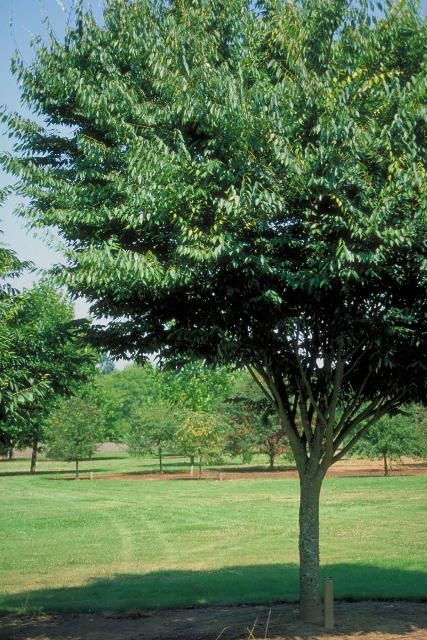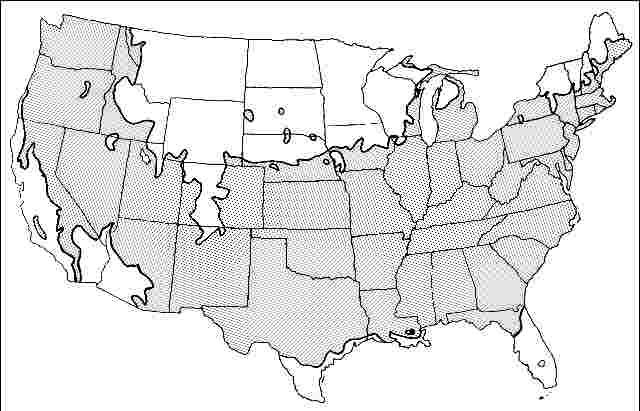Introduction
`Village Green' somewhat resembles the vase shape of American Elms, is tolerant of pollution, makes a great city street tree and produces a shorter and wider tree than `Green Vase' Zelkova. `Village Green' is reportedly more cold tolerant than `Green Vase'. Zelkova is often listed as a replacement for American Elm since it has roughly the same vase shape and grows 50 to 60 feet tall with a 50 to 60-foot spread. But no tree will truly match the grace and elegance of the American Elm. Zelkova is massive, with the trunk capable of growing to four feet or more in diameter. It has a moderate growth rate and likes a sunny exposure. Branches are more numerous and smaller in diameter than American Elm. Major branches grow very upright and provide easy clearance for tall vehicles below making it quite suitable as a street tree. Leaves are 1.5 to 4 inches long, turning a brilliant rusty red or bronze in the fall.

Credit: Ed Gilman
General Information
Scientific name: Zelkova serrata
Pronunciation: zell-KOE-vuh sair-AY-tuh
Common name(s): 'Village Green' Japanese Zelkova, `Village Green' Saw-Leaf Zelkova
Family: Ulmaceae
USDA hardiness zones: 5A through 8B (Fig. 2)
Origin: not native to North America
Invasive potential: little invasive potential
Uses: urban tolerant; highway median; street without sidewalk; shade; parking lot island 100-200 sq ft; parking lot island > 200 sq ft; sidewalk cutout (tree pit); tree lawn 4-6 feet wide; tree lawn > 6 ft wide
Availability: not native to North America

Description
Height: 50 to 60 feet
Spread: 45 to 50 feet
Crown uniformity: symmetrical
Crown shape: vase
Crown density: moderate
Growth rate: moderate
Texture: fine
Foliage
Leaf arrangement: alternate (Fig. 3)
Leaf type: simple
Leaf margin: serrate
Leaf shape: oblong, ovate
Leaf venation: pinnate
Leaf type and persistence: deciduous
Leaf blade length: less than 2 inches
Leaf color: green
Fall color: copper, red
Fall characteristic: showy
Flower
Flower color: unknown
Flower characteristics: not showy
Fruit
Fruit shape: oval
Fruit length: less than .5 inch
Fruit covering: dry or hard
Fruit color: unknown
Fruit characteristics: does not attract wildlife; not showy; fruit/leaves not a litter problem
Trunk and Branches
Trunk/bark/branches: branches don't droop; showy; typically one trunk; thorns
Pruning requirement: needed for strong structure
Breakage: susceptible to breakage
Current year twig color: brown
Current year twig thickness: thin
Wood specific gravity: unknown
Culture
Light requirement: full sun
Soil tolerances: sand; loam; clay; slightly alkaline; acidic; occasionally wet; well-drained
Drought tolerance: high
Aerosol salt tolerance: moderate
Other
Roots: not a problem
Winter interest: no
Outstanding tree: yes
Ozone sensitivity: unknown
Verticillium wilt susceptibility: resistant
Pest resistance: resistant to pests/diseases
Use and Management
Unfortunately, the branches on Zelkova are often clumped together on the trunk at one point. Double and multiple trunks or leaders with embedded bark are also common. This is not a desirable form for planting in urban areas and needs to be prevented, or corrected, on existing trees. Purchase trees with branches spaced along the trunk so they can develop a secure hold onto the trunk. These will be hard to find but insist on it! Be sure that branches remain less than about half the diameter of the trunk to maintain a strong, durable form. Encourage nurserymen to grow trees with good trunk and branch structure.
The tree will tolerate most soil types, including those with a pH to about 7.5, but prefers a moist deep loam. It is reportedly risky to transplant in the fall. Established trees are fairly drought-tolerant, requiring little irrigation unless located in sandy soil. It makes a wonderful street tree even in restricted-soil tree pits, and is almost pest free. The crowns will eventually grow together if trees are planted on 30-foot-centers, forming a wonderful shaded street. This is a tough, urban tree which is often planted along streets in downtown and residential areas.
Cultivars include: `Village Green' also resembles the shape of the American Elm and is more winter hardy than `Green Vase', and may have a straighter trunk.
Diseases
Normally disease-free as it resists Dutch Elm disease, Elm leaf beetle and Japanese beetles.
Zelkova is subject to canker diseases particularly if the trunk is repeatedly wounded. Avoid wounding and maintain tree health.